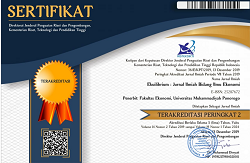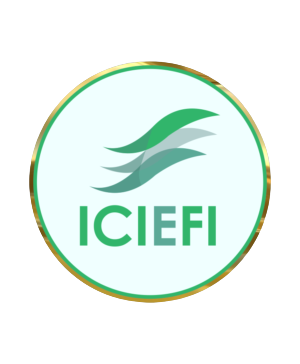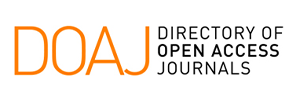Determinants of the Successful Digital Campaigns on Zakat: an Analysis Based on Islamic Marketing Perspective
DOI: 10.24269/ekuilibrium.v18i1.2023.pp94-109
Abstract
Zakat campaigns have taken place from time to time in various phases of muslim history. The zakat campaign has been said to be effective, but evidence in Indonesia shows that the zakat literacy of muslim communities is not yet high, they also tend to choose to distribute zakat directly, and there is a wide gap between the potential and reality of zakat collection. This study aims to examine the determinants that influence the success of a digital zakat campaign, consisting of content or messages in the zakat campaign, amil or zakat campaigners, campaign target digital literacy, social media as a campaign platform, and campaign methods. This research is a quantitative research, with respondents consisting of 100 muzakki (zakat donator) at LAZ Dompet Dhuafa Waspada North Sumatra, Indonesia. Data analysis techniques using descriptive statistics and SEM-PLS using SmartPLS 4.0 software. The results of the study show that content and social media have an effect but not significant on the success of the zakat digital campaign. Meanwhile, the amil factor and campaign method have a significant effect on the success of the zakat digital campaign. Meanwhile, digital literacy has a negative and insignificant effect on digital zakat campaigns. The results of this study indicate the importance of amil positioning in the success of the zakat campaign. This study proposes that zakat institutions cadre their own amil celebrities.
Keywords
References
- Allison, T. H., Davis, B. C., Short, J. C., & Webb, J. W. (2015). Crowdfunding in a prosocial microlending environment: Examining the role of intrinsic versus extrinsic cues. Entrepreneurship: Theory and Practice, 39(1), 53–73. https://doi.org/10.1111/etap.12108
- Anderson, J. C., & Gerbing, D. W. (1984). The effect of sampling error on convergence, improper solutions, and goodness-of-fit indices for maximum likelihood confirmatory factor analysis. Psychometrika. https://doi.org/10.1007/BF02294170
- Andreasen, A. R. (1994). Social marketing: Its definition and domain. Journal of Public Policy & Marketing. https://doi.org/10.1177/074391569401300109
- Anggreiny, S. (2021). Strategi Penghimpunan ZIS (Zakat, Infaq Dan Sedekah) Melalui Digital QRIS Di BAZNAS Provinsi Kalimantan Tengah. digilib.iain-palangkaraya.ac.id. http://digilib.iain-palangkaraya.ac.id/3508/
- Arham, M. (2010). Islamic perspectives on marketing. Journal of Islamic Marketing, 1(2), 149–164. https://doi.org/10.1108/17590831011055888
- Benedict, E., & Ariestya, A. (2020). The Influence of Social Media (Instagram) Usage on Donation Attitude through the Crowdfunding Platform. International Journal of New Media …. https://kc.umn.ac.id/19199/
- Bhati, A., & McDonnell, D. (2020). Success in an online giving day: The role of social media in fundraising. In Nonprofit and Voluntary Sector …. journals.sagepub.com. https://doi.org/10.1177/0899764019868849
- Bhattacharya, C. B., & Bolton, R. N. (2000). Relationship Marketing in Mass Markets. Handbook of Relationship Marketing, Sheth JN y Parvatiyar A. Sage Publications: Thousand Oaks ….
- Boyd, A. D., & Buchwald, D. (2022). Factors That Influence Risk Perceptions and Successful COVID-19 Vaccination Communication Campaigns With American Indians. In Science Communication (Vol. 44, Issue 1, pp. 130–139). https://doi.org/10.1177/10755470211056990
- Bünzli, F. (2022). Improving the effectiveness of prosocial advertising campaigns: Message strategies to increase support from less empathic individuals. Journal of Philanthropy and Marketing. https://doi.org/10.1002/nvsm.1711
- Chen, G. M., Chou, D., Pan, B., & Chang, C. (2008). An analysis of Tzu Chi’s public communication campaign on body donation. digitalcommons.uri.edu. https://digitalcommons.uri.edu/com_facpubs/9/
- Dafiq, M. I., Rohim, A. N., & Priyatno, P. D. (2021). Strategy Analysis of Zis Fund Collection During The Covid-19 Pandemic at Baznas DKI Jakarta Province. El-Barka: Journal of Islamic Economics and …. https://jurnal.iainponorogo.ac.id/index.php/elbarka/article/view/3231
- Dann, S. (2010). Redefining social marketing with contemporary commercial marketing definitions. Journal of Business Research. https://www.sciencedirect.com/science/article/pii/S0148296309000319
- Ebrahim, R. S. (2020). The role of trust in understanding the impact of social media marketing on brand equity and brand loyalty. Journal of Relationship Marketing. https://doi.org/10.1080/15332667.2019.1705742
- Erdoğmuş, İ. E., & Cicek, M. (2012). The impact of social media marketing on brand loyalty. Procedia-Social and Behavioral Sciences. https://www.sciencedirect.com/science/article/pii/S1877042812045818
- Hafidhuddin, D. (2006). Analisis efektivitas promosi lembaga amil zakat dalam penghimpunan zakat bagi peningkatan kesejahteraan keluarga dhuafa (Studi kasus lembaga amil zakat …. Media Gizi Dan Keluarga. https://journal.ipb.ac.id/index.php/mediagizi/article/view/7216
- Hair, J. F., Risher, J. J., Sarstedt, M., & Ringle, C. M. (2019). When to use and how to report the results of PLS-SEM. European Business Review, 31(1), 2–24. https://doi.org/10.1108/EBR-11-2018-0203
- Herlin, Ghanny, A. R., Afandi, Y., & Zaenal, M. H. (2020). Zakat Literacy Index among Millenials. PUSKAS-BAZNAS, 1–9. https://www.puskasbaznas.com/publications/published/pwps/1442-zakat-literacy-index-among-millenials
- Ho, H. C., Chiu, C. L., Mansumitrchai, S., Yuan, Z., & ... (2021). The influence of signals on donation crowdfunding campaign success during COVID-19 crisis. International Journal of …. https://www.mdpi.com/1660-4601/18/14/7715
- Ho, M. L., Cowling, B. J., Seto, W. H., Wong, L. C., & ... (2014). Determinants of an effective antibiotic campaign: Lessons from Hong Kong. Journal of Global …. https://www.sciencedirect.com/science/article/pii/S2213716514000964
- Iacobucci, D. (2010). Structural equations modeling: Fit indices, sample size, and advanced topics. Journal of Consumer Psychology. https://www.sciencedirect.com/science/article/pii/S1057740809001120
- Ichwan, A. (2020). Pengaruh technology acceptance model terhadap keputusan muzakki membayar zakat melalui fintech gopay. Jurnal Ilmiah Ekonomi Islam. https://www.jurnal.stie-aas.ac.id/index.php/jei/article/view/1011
- Jogiyanto, H. M., & Abdillah, W. (2009). Konsep dan aplikasi PLS (Partial Least Square) untuk penelitian empiris. In BPFE Fakultas Ekonomika dan Bisnis UGM ….
- Kaartemo, V. (2017). The elements of a successful crowdfunding campaign: A systematic literature review of crowdfunding performance. In International Review of Entrepreneurship. academia.edu. https://www.academia.edu/download/54352470/elements_of_a_successful_crowdfunding_campaign.pdf
- Kahf, M. (1999). The principle of socio-economic justice in the contemporary Fiqh of Zakah. In IQTISAD Journal of Islamic Economics. monzer.kahf.com. http://monzer.kahf.com/papers/english/socioeconomic_justice.pdf
- Kim, T., Por, M. H., & Yang, S. B. (2017). Winning the crowd in online fundraising platforms: The roles of founder and project features. Electronic Commerce Research and …. https://www.sciencedirect.com/science/article/pii/S1567422317300613
- Koch, J. A., & Siering, M. (2019). The recipe of successful crowdfunding campaigns: an analysis of crowdfunding success factors and their interrelations. Electronic Markets. https://doi.org/10.1007/s12525-019-00357-8
- Koltay, T. (2011). The media and the literacies: Media literacy, information literacy, digital literacy. Media, Culture & Society. https://doi.org/10.1177/0163443710393382
- Korzynski, P., Haenlein, M., & Rautiainen, M. (2021). Impression management techniques in crowdfunding: An analysis of Kickstarter videos using artificial intelligence. European Management Journal. https://www.sciencedirect.com/science/article/pii/S0263237321000013
- Kotler, P. R., & Andreasen, A. R. (2013). Strategic Marketing for Non-Profit Organisations: Pearson New International Edition. Pearson Higher Ed.
- Kurnia, N., & Astuti, S. I. (2017). Peta gerakan literasi digital di Indonesia: studi tentang pelaku, ragam kegiatan, kelompok sasaran dan mitra. In Informasi. academia.edu. https://www.academia.edu/download/70438781/pdf_1.pdf
- Latifah, L., Susilowati, N., Ardiansah, M. N., & ... (2022). Social Media Networking and Knowledge Sharing in Increasing Innovation and MSME’s Growth: Based on the Theory of Communication Visibility. Ekuilibrium: Jurnal Ilmiah Bidang Ilmu Ekonomi, 17(2). https://journal.umpo.ac.id/index.php/ekuilibrium/article/view/5329
- Liu, Y., Chen, Y., & Fan, Z. P. (2021). Do social network crowds help fundraising campaigns? Effects of social influence on crowdfunding performance. Journal of Business Research. https://www.sciencedirect.com/science/article/pii/S0148296320305506
- Mahmud, A. A. H. (2002). Fiqh Da’wah Ilaallah. Jakarta Timur: Studia Press.
- Mulyono, D. (2016). Pengaruh media sosial terhadap keputusan memberikan donasi pada Rumah Zakat. repository.ipb.ac.id. https://repository.ipb.ac.id/handle/123456789/82803
- Nasution, J. (2021). DISTRIBUTION AND EMPOWERMENT OF ZAKAT IN MAQASID SHARIA PERSPECTIVE (Case Study of Dompet Dhuafa Waspada). In At-tijaroh: Jurnal Ilmu Manajemen dan Bisnis Islam. scholar.archive.org. https://scholar.archive.org/work/oss7eonmsrei7atslvpkcowbyq/access/wayback/http://jurnal.iain-padangsidimpuan.ac.id/index.php/attijaroh/article/download/4365/pdf
- Nasution, J. (2022). Strategi Digital Fundraising Zakat di Indonesia. Jurnal Edukasi (Ekonomi, Pendidikan Dan Akuntansi …. https://jurnal.unigal.ac.id/index.php/edukasi/article/view/8648
- Owoyemi, M. Y. (2020). Zakat management: The crisis of confidence in zakat agencies and the legality of giving zakat directly to the poor. Journal of Islamic Accounting and Business Research, 11(2), 498–510. https://doi.org/10.1108/JIABR-07-2017-0097
- Pietro, F. D., Spagnoletti, P., & Prencipe, A. (2019). Fundraising across digital divide: Evidences from charity crowdfunding. Organizing for Digital Innovation. https://doi.org/10.1007/978-3-319-90500-6_9
- PUSKAS BAZNAS. (2020). Efektivitas Kampanye Zakat Terhadap Brand Lembaga dan Pengumpulan Zakat. Center of Strategic Studies, The National Board of Zakat Republic of Indonesia. https://puskasbaznas.com/publications/books/1235-efektivitas-kampanye-zakat-terhadap-brand-lembaga-dan-pengumpulan-zakat
- PUSKAS BAZNAS. (2021). Indonesia Zakat Outlook 2021 Center of Strategic Studies the National Board of Zakat. Center of Strategic Studies, The National Board of Zakat Republic of Indonesia. www.baznas.go.id;
- Quadrelli, B. (2017). Fundraising across digital divide: evidences from charity crowdfunding. tesi.luiss.it. http://tesi.luiss.it/19049/1/669351_QUADRELLI_BRUNO.pdf
- Rashid, A. A., Idris, M. I., Zulkiflee, N. S., Yahaya, A. Y., & ... (2021). The correlation of social media activity and engagement of a health NGO with the outcome of fundraising efforts during the COVID-19 pandemic. Bangladesh Journal of …. https://www.banglajol.info/index.php/BJMS/article/view/55419
- Rudianto, R., Misrofingah, M., Prayoga, D., & ... (2022). Understanding Management Marketing in Digitalization and Automation Times. Ekuilibrium: Jurnal Ilmiah Bidang Ilmu Ekonomi, 17(2). https://journal.umpo.ac.id/index.php/ekuilibrium/article/view/5145
- Salido-Andres, N. (2022). When the winner takes it all: online campaign factors influencing the success of donation-based crowdfunding for charitable causes. International Review on Public and Nonprofit Marketing, 19(4), 763–780. https://doi.org/10.1007/s12208-021-00320-4
- Salido-Andrés, N. (2019). Determinants of success of donation-based crowdfunding through digital platforms: The influence of offline factors. CIRIEC-Espana Revista de Economia Publica, Social y Cooperativa, 95, 119–141. https://doi.org/10.7203/CIRIEC-E.95.13001
- Sargeant, A. & Jay. (2004): Fundraising Management: Analysis. In Planning and Practice, London, New York.
- Sargeant, A. (2007). The relational determinants of nonprofit Web site fundraising effectiveness: An exploratory study. Nonprofit Management and Leadership, 18(2), 141–156. https://doi.org/10.1002/nml.178
- Sargeant, Adrian, & Shattuck, S. (2017). Digital Fundraising. Fundraising Principles and Practice, 318–359. https://doi.org/10.1002/9781119228974.ch11
- Saxton, G. D., & Wang, L. (2014). The social network effect: The determinants of giving through social media. Nonprofit and Voluntary Sector …. https://doi.org/10.1177/0899764013485159
- Smyth, I. (1991). The Indonesian family planning programme: a success story for women? Development and Change. https://doi.org/10.1111/j.1467-7660.1991.tb00434.x
- Tafesse, W. (2021). Communicating crowdfunding campaigns: How message strategy, vivid media use and product type influence campaign success. Journal of Business Research, 127, 252–263. https://doi.org/10.1016/j.jbusres.2021.01.043
- Tafesse, W., & Wien, A. (2018). Implementing social media marketing strategically: an empirical assessment. Journal of Marketing Management. https://doi.org/10.1080/0267257X.2018.1482365
- Tan, S. (2021). Tingkat Kompetensi Literasi Digital Berdasarkan Digital Literacy Global Framework (DLGF) dalam Menghadapi Infodemi Covid-19 di Kalangan Generasi Z Kota …. repositori.usu.ac.id. https://repositori.usu.ac.id/handle/123456789/44494
- Trindade, G. (2017). Determinants of the crowdfunding campaign success in the areas of music and sports. In Iberian Conference on Information Systems and Technologies, CISTI. https://doi.org/10.23919/CISTI.2017.7975859
- Vergeer, M., & Hermans, L. (2013). Campaigning on Twitter: Microblogging and online social networking as campaign tools in the 2010 general elections in the Netherlands. Journal of Computer-Mediated …. https://academic.oup.com/jcmc/article-abstract/18/4/399/4067483
- Wachira, E. W., & Wachira, V. K. (2021). Crowdfunding in Kenya: Factors for successful campaign: The case of Kickstarter crowdfunding platform. Public Finance Quarterly, 66(3), 413–428. https://doi.org/10.35551/PFQ_2021_3_6
- Wolfe, M. T. (2021). Shock and awe: Loudness and unpredictability in Twitter messages and crowdfunding campaign success. Journal of Innovation and Knowledge, 6(4), 246–256. https://doi.org/10.1016/j.jik.2021.06.002
- Zaidan, A. K. (2001). Ushul al-Da’wah. Beirut: Muassasah al-Risâlah.
- Zhou, H., & Ye, S. (2021). Fundraising in the digital era: Legitimacy, social network, and political ties matter in China. VOLUNTAS: International Journal of Voluntary and …. https://doi.org/10.1007/s11266-019-00112-9
Refbacks
- There are currently no refbacks.

This work is licensed under a Creative Commons Attribution-ShareAlike 4.0 International License.













